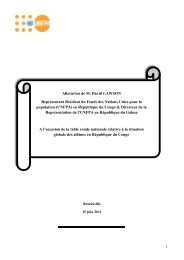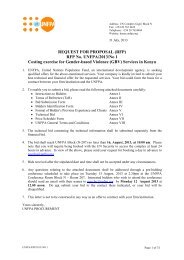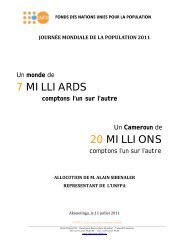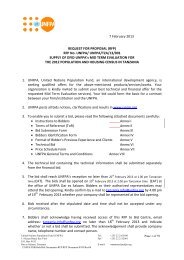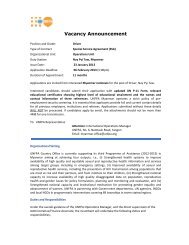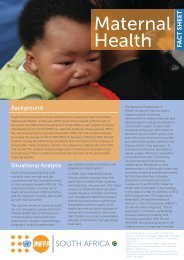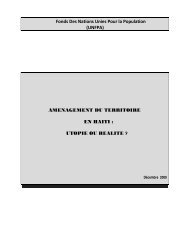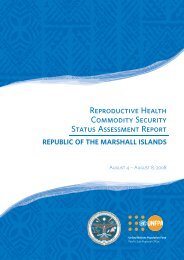A reproductive health needs assessment in Myanmar
A reproductive health needs assessment in Myanmar
A reproductive health needs assessment in Myanmar
Create successful ePaper yourself
Turn your PDF publications into a flip-book with our unique Google optimized e-Paper software.
A Reproductive Health Needs Assessment <strong>in</strong> <strong>Myanmar</strong><br />
between reported symptoms and the presence of <strong>in</strong>fection as documented by cl<strong>in</strong>ical and<br />
laboratory exam, it is not clear how well these reported symptoms describe the actual<br />
situation concern<strong>in</strong>g RTIs <strong>in</strong> the community.<br />
Table 12. Prevalence of RTIs <strong>in</strong> a Women’s Out-Patient Department (per cent)<br />
Present<strong>in</strong>g Gonorrhoea Trichomonas Candida Syphilis (VDRL+) N<br />
symptom<br />
vag<strong>in</strong>alis<br />
White discharge 0.8 10.5 0.8 2.8 247<br />
Pelvic Pa<strong>in</strong> 4.0 3.0 - 2.0 99<br />
Source: Kh<strong>in</strong> My<strong>in</strong>t Wai et al. (1997) Reproductive Tract Infections among OPD attendees<br />
of Central Women’s Hospital, Yangon<br />
In all the townships visited by the RH <strong>assessment</strong> team, both government <strong>health</strong> workers and<br />
private general practitioners (GPs) reported see<strong>in</strong>g STD patients <strong>in</strong> their cl<strong>in</strong>ics, however, the<br />
number of patients varied considerably. Government STD teams reported that the number of<br />
clients at their cl<strong>in</strong>ics ranged from 3 to 30 per day. While some community members were<br />
not aware of STDs, many people <strong>in</strong>terviewed believed that STDs were quite prevalent <strong>in</strong> their<br />
community. Health care providers of various types shared the op<strong>in</strong>ion that STDs were<br />
common.<br />
Syphilis (VDRL) serosurveillance has recently been <strong>in</strong>cluded with<strong>in</strong> the national HIV<br />
sent<strong>in</strong>el surveillance programme and behavioural sent<strong>in</strong>el surveillance was <strong>in</strong>troduced <strong>in</strong> the<br />
sent<strong>in</strong>el surveillance sites <strong>in</strong> Yangon and Mandalay for the first time <strong>in</strong> September 1997. The<br />
behavioural sent<strong>in</strong>el surveillance attempts to l<strong>in</strong>k HIV prevalence data with <strong>in</strong>formation on<br />
the frequency of high-risk behaviours. Questionnaires are adm<strong>in</strong>istered at the time of blood<br />
sampl<strong>in</strong>g, ask<strong>in</strong>g <strong>in</strong>dividuals <strong>in</strong> the surveillance programme to provide <strong>in</strong>formation on<br />
condom use, symptoms of other STDs, and sexual and drug use practices. Table 13<br />
summarises this data for the first round of behavioural surveillance, conducted <strong>in</strong> September<br />
and October, 1997. The sample <strong>in</strong>cluded 632 <strong>in</strong>dividuals from Yangon and 417 from<br />
Mandalay (Department of Health 1997).<br />
Table 13. Results from first round of behavioural sent<strong>in</strong>el surveillance<br />
Sent<strong>in</strong>el Number Regular # of partners past IDU Needle VDRL Discharge Ulcer<br />
Group screened condom use 6 months (range) alone shar<strong>in</strong>g positive<br />
Male STD 180 7.8 l-5 2.8 1.1 N/A 11.1 30.6<br />
Clients<br />
Female 72 4.2 l-5 1.7 N/A 43.9 12.5 11.1<br />
STD<br />
Clients<br />
Sex 201 34.3 1- 100 2.5 N/A 41.0 3.5 4.0<br />
Workers<br />
Injection 80 28.8 0-5 86.2 58.8 N/A 8.8 10.0<br />
Drug<br />
Users<br />
Pregnant 307 2.0 1 N/A N/A 8.8 0.3 1.6<br />
Women<br />
Blood 209 8.6 0-2 0.5 0.5 N/A N/A 1.9<br />
Donors<br />
Source: Department of Health (1997) Sent<strong>in</strong>el Surveillance Data for September 1997.<br />
Yangon: AIDS Prevention and Control Project.<br />
41




